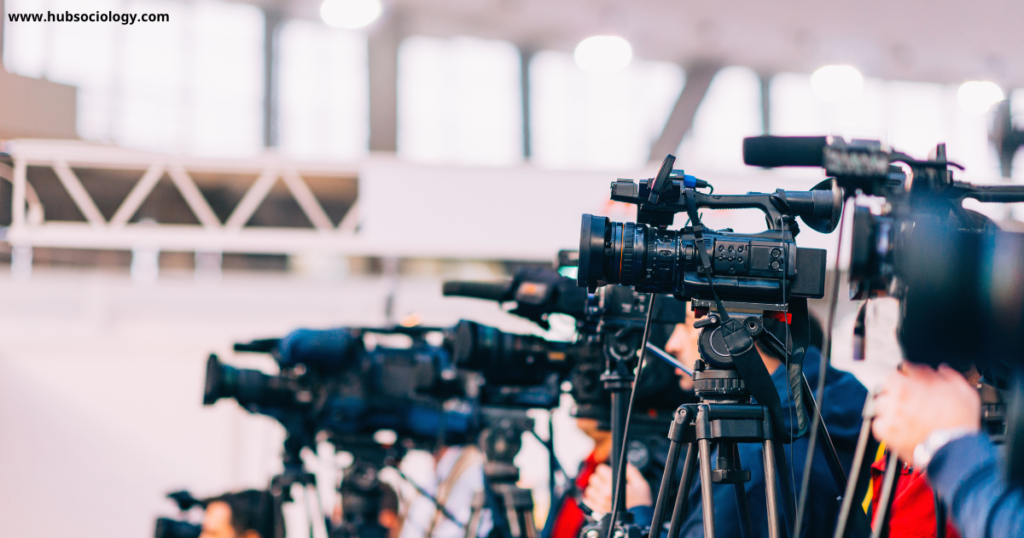Introduction on Risk in Mass Media
In contemporary society, risk has become a central theme in public life. Risks are not only material or environmental but also discursive, shaped by how they are represented, circulated, and understood in the public domain. Among the most influential institutions in shaping public perception of risk is the mass media. Whether through television, newspapers, social media, or digital platforms, mass media plays a decisive role in constructing, amplifying, or minimizing risks. In sociology, the study of “risk in mass media” examines how risk is communicated, who defines it, and how these representations influence public behavior, governance, and social trust.
This article analyzes the sociological dimensions of risk in mass media by focusing on theories of risk society, agenda-setting, framing, moral panics, and the consequences of media-driven risk narratives.

Table of Contents
Risk as a Social Construct
From a sociological standpoint, risk is not simply an objective measurement of probability or harm. Rather, it is socially constructed, interpreted, and given meaning by cultural, political, and media processes. Ulrich Beck’s Risk Society (1992) highlights how modern societies are increasingly preoccupied with risks generated by industrialization, technology, and globalization. Yet these risks are not evenly visible; they become part of the collective consciousness largely through media representations.
For instance, climate change, terrorism, pandemics, and cybercrime are risks whose actual probabilities are debated by experts, but their presence in public life is significantly shaped by media coverage. The media thus becomes a mediator of knowledge, translating complex scientific or political issues into narratives accessible to ordinary citizens.
Media as a Risk Amplifier
One of the most significant contributions of sociology to understanding risk in media is the Social Amplification of Risk Framework (SARF). According to this framework, risks are not only physical threats but also social phenomena that can be amplified or attenuated depending on how they are communicated.
- Amplification occurs when the media repeatedly emphasizes a risk, dramatizes its potential consequences, or frames it in emotionally charged language. For example, the 24-hour coverage of terrorist attacks after 9/11 amplified fear of terrorism globally, even though statistically the likelihood of being affected by terrorism remained extremely low.
- Attenuation, on the other hand, happens when risks are downplayed or underreported. For example, everyday workplace hazards, road accidents, or long-term environmental degradation may receive less coverage, thus muting public concern.
The selective amplification of some risks over others reflects media priorities, news values, and sometimes political or corporate interests.
Framing and Agenda-Setting on Risk in Mass Media
Sociological studies of media emphasize two interrelated processes in risk communication: agenda-setting and framing.
- Agenda-setting theory (McCombs and Shaw, 1972) suggests that the media does not tell people what to think, but what to think about. By giving prominence to certain risks (e.g., pandemics, cyberattacks, or celebrity scandals) while ignoring others (e.g., structural poverty, malnutrition), the media influences what issues are perceived as urgent.
- Framing theory goes a step further. It argues that media does not simply report facts but interprets them through certain frames. For instance, a disease outbreak can be framed as a medical emergency, a failure of government policy, or a moral issue tied to lifestyle choices. Each frame directs attention toward different solutions and responsibilities.
In this sense, the media does not merely reflect risk but actively constructs its meaning within society.
Moral Panics and Media Risk Narratives
The concept of moral panic (Cohen, 1972) is central to understanding how risks in media sometimes spiral into widespread societal fear. Moral panics occur when the media exaggerates threats posed by particular groups, behaviors, or events, creating “folk devils” who are blamed for social problems.
Classic examples include the portrayal of youth subcultures in the 1960s, drug scares in the 1980s, and more recently, media-driven fears around immigration, online gaming, or social media addiction. These panics often lead to disproportionate policy responses, surveillance, or stigmatization of marginalized groups.
In these cases, the risk is less about empirical danger and more about symbolic threats to social order and morality. Media, therefore, plays a crucial role in constructing not just awareness of risks but also shaping who is seen as responsible for them.
The Digital Age: Risk in Social Media
The rise of social media platforms has transformed the landscape of risk communication. Unlike traditional mass media, where gatekeepers controlled content, social media allows for rapid, decentralized, and viral spread of risk narratives.

- Misinformation and disinformation: During crises such as the COVID-19 pandemic, false information about cures, vaccines, or conspiracies spread widely, amplifying risks and undermining trust in scientific institutions.
- Algorithmic amplification: Social media algorithms prioritize sensational, emotionally engaging content, which often includes fear-inducing or risk-laden stories.
- Participatory risk communication: Citizens are no longer passive recipients but active creators of risk narratives, sharing personal stories, images, and videos that shape collective perceptions.
While social media democratizes information flow, it also intensifies uncertainty, as distinguishing between credible and misleading sources becomes increasingly difficult.
Risk, Inequality and Representation in Media
Sociology also highlights that risks in media are unevenly represented across social groups. The risks faced by marginalized communities—such as unsafe working conditions, inadequate healthcare, or exposure to pollution—often receive less media attention compared to risks affecting elites or middle classes.
For example, natural disasters in developing countries may be briefly covered as humanitarian stories but rarely receive the sustained attention given to risks that directly affect industrialized nations. This reflects global inequalities in media representation and reinforces existing social hierarchies.
Moreover, groups such as migrants, ethnic minorities, and the poor are often constructed as “risk factors” themselves—portrayed as threats to security, culture, or social stability—rather than as communities at risk.
Risk, Trust and Governance
The way risks are portrayed in media has profound implications for social trust and governance. Public trust in science, government, and institutions is mediated through how risks are reported. For instance, conflicting media narratives about climate change or vaccination can create confusion, skepticism, and even resistance to public health measures.
Governments also strategically use media to manage risks. During national crises, official communication often relies on mass media to encourage compliance, foster unity, or justify emergency policies. However, if media coverage highlights government failures, this can lead to political instability and erosion of legitimacy.
Thus, risk in media is not only about knowledge but also about power—who controls the narrative, whose risks are prioritized, and whose voices are silenced.
Towards a Reflexive Understanding of Risk in Media
In an age where global risks such as pandemics, climate change, and cyber threats dominate, it is crucial to cultivate a reflexive understanding of how media shapes risk. Citizens must critically assess media content, identify frames, and recognize the political and cultural interests behind risk narratives.
Media literacy programs, ethical journalism, and transparent regulation of digital platforms can help mitigate the dangers of risk amplification while ensuring that marginalized risks receive due attention. From a sociological perspective, this reflexivity is essential for building a more informed and equitable public discourse around risk.
Conclusion on Risk in Mass Media
Risk in mass media is not merely about reporting objective dangers but about constructing social realities. Media acts as a powerful institution that amplifies, frames, and sometimes distorts risks, influencing how individuals and societies respond to uncertainty. Sociological analysis reveals that risks in media are deeply entangled with issues of power, inequality, and moral order.

As media ecosystems evolve in the digital age, risks themselves multiply—not only the risks being reported but also the risks of misinformation, polarization, and manipulation. Understanding the sociological dimensions of risk in mass media is therefore vital for navigating contemporary society, where perception often shapes reality as much as material threats do.
Exam-style questions on Risk in Mass Media
5 Marks Questions on Risk in Mass Media (Short Answer)
- Define the concept of risk from a sociological perspective.
- What is meant by the “social amplification of risk” in mass media?
- Explain the difference between risk amplification and risk attenuation in media.
- What is agenda-setting in mass media?
- Give one example of moral panic created by media.
10 Marks Questions on Risk in Mass Media (Medium Answer)
- Discuss how framing theory helps us understand risk communication in mass media.
- Explain the role of social media in spreading risk narratives in the digital age.
- How does media representation of risks reflect social inequalities? Give examples.
- What are the implications of media-driven risks for public trust in government and institutions?
- Analyze the concept of “moral panic” in the context of media risk construction.
15 Marks Questions on Risk in Mass Media (Long Answer / Essay)
- Critically examine the role of mass media as a risk amplifier and attenuator in society.
- Discuss Ulrich Beck’s Risk Society in relation to media representations of global risks.
- Evaluate the sociological significance of misinformation and disinformation in the age of social media.
- How do power relations influence which risks are highlighted or ignored in mass media? Illustrate with examples.
- “Risk in mass media is not just about danger, but about social construction and control.” Discuss.
